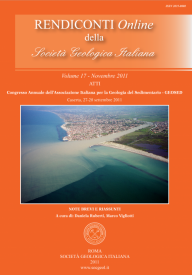
Studio sedimentologico e dinamica marino-costiera del sistema litorale di Bosco Pantano di Policoro (Basilicata, Italia meridionale)
Sabato L. (*), Longhitano S. (**), Cilumbriello A. (*), Gioia D. (*), Spalluto L. (*) & Kalb C. (***)
(*) Dipartimento di Scienze della Terra e Geoambientali, Università degli Studi di Bari "Aldo Moro". E-mail: l.sabato@geo.uniba.it
(**) Dipartimento di Scienze Geologiche, Università degli Studi della Basilicata, Potenza.
(***) OCEANS-Dipartimento di Scienze della Terra, Università degli Studi di Cagliari.
Volume: 17/2011
Pages: 161-168
Abstract
Sedimentological study and coastal-marine dynamics of the "Bosco Pantano di Policoro" littoral system (Basilicata, Southern Italy).
The PROVIDUNE LIFE project is a multi-disciplinary research task funded by the European Community and designed to outline the framework of the natural habitats of the dune fields that occur along the coasts of Cagliari (southern Sardinia), Caserta (northwestern Campania) and Policoro (eastern Basilicata) in southern Italy. The project consists of a number of interconnected studies programmed to evaluate all the environmental features that the coastal dune fields exhibit along these coasts of the central Mediterranean area. This paper shows the result of the sedimentological study performed to characterize the "Bosco Pantano di Policoro e Costa Ionica Foce Sinni" coastal system, in Basilicata (southern Italy). This system, developing along a 3 km-long segment of the Ionian coast, shows an up to 100 m-wide, mixed (gravelly-sandy) beach, which is wave-dominated and subjected to persistent NNW-directed waves. The study has been focused on the morpho-sedimentological characterization of both the emerged and the submerged sectors of the beach system. Accordingly, 36 topographic and bathymetric profiles have been measured, and analyses to obtain compositional and textural features of deposits were carried out. Furthermore, an evolutive model of the shoreline changes during the last 100 years has been depicted on the base of a multitemporal comparison of historical aerial photos. Finally, in order to achieve a series of prediction models on the impact of the dominant wave and the resulting hydrodynamics of the coastal area, the more frequent and of greater energy events have been identifi ed and, thanks to the Delft3D software, the effects they can have on coastal systems have been evaluated.
This kind of study provides all the geological elements that must be taken into account for any planning of interventions as well as for their management; in any case, the result should be used for the purpose to protect coastal habitat, that is the ultimate goal of this LIFE project.
Keywords
LIFE Project, PROVIDUNE, sedimentology, coastal system, Policoro, Sinni River, SIC area, Southern Italy
Get Full Text